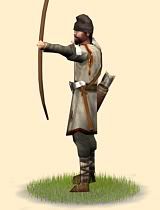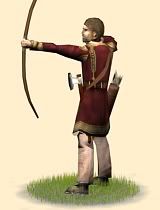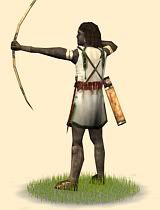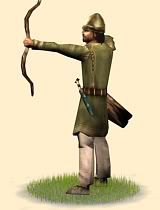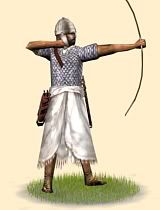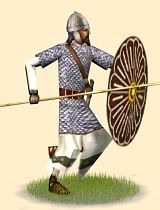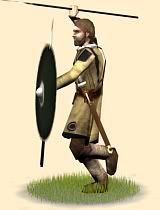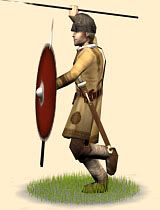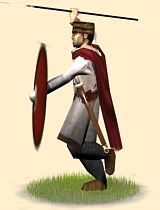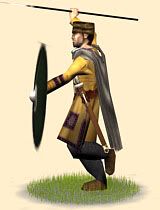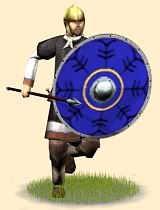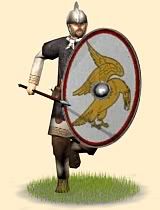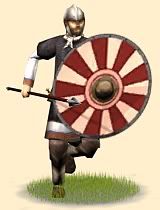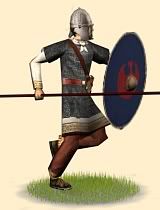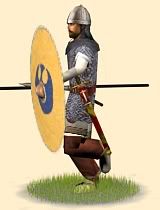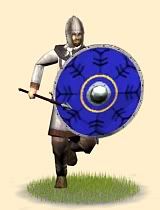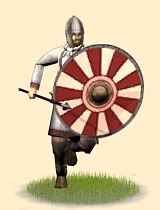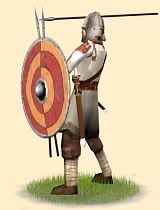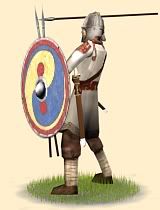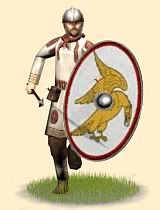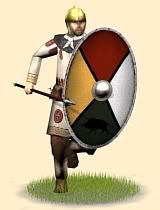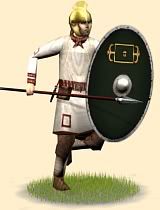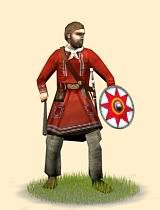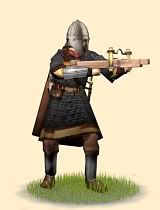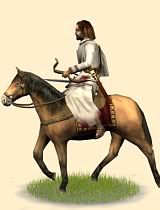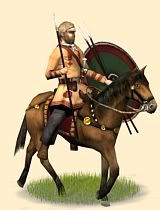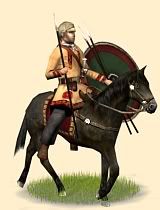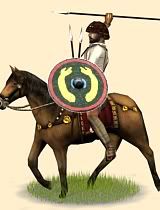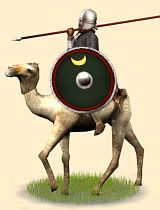There are 5 roman factions contained within INVASIO BARBARORVM : SOMNIUM APOSTATAE IULIANI. These are:
Imperium Julianorum (355AD and 361AD Campaigns)
Video by Pseudo Romanus
Julian, born in 331 in Constantinople, was the son of Julius Constantius, half brother of Emperor Constantine I, and his second wife, Basilina. His paternal grandparents were Western Roman Emperor Constantius Chlorus and his second wife, Flavia Maximiana Theodora. His maternal grandfather was Caeionius Iulianus Camenius. In the turmoil after the death of Constantine in 337, in order to establish himself as sole emperor, Julian's zealous Arian Christian cousin Constantius II led a massacre of Julian's family. Constantius ordered the murdering of many descendants from the second marriage of Constantius Chlorus and Theodora, leaving only Constantius and his brothers Constantine II and Constans, and their cousins Julian and Gallus, Julian's half brother, as surviving males related to Emperor Constantine. Constantius II, Constans, and Constantine II were proclaimed joint emperors, each ruling a portion of Roman territory. Constantius II then saw to a strict Arian Christian education of the surviving Julian and his brother Gallus. In traditional accounts of his life, considerable weight is given to Julian’s early psychological development and education. Initially growing up in Bithynia, raised by his maternal grandmother, at the age of seven he was tutored by Eusebius, the Arian Christian Bishop of Nicomedia, and Mardonius, a Gothic eunuch. However, in 342, both Julian and his half-brother Gallus were exiled to the imperial estate of Macellum in Cappadocia. Here he met the Christian bishop George. At the age of 18, the exile was lifted and he dwelt briefly in Constantinople and Nicomedia.
In 351, Julian returned to Asia Minor to study Neoplatonism under Aedesius, and later to study the Iamblichan Neoplatonism from Maximus of Ephesus. During his studies in Athens, Julian met Gregory Nazianzus and Basil of Caesarea, two Christian saints. \n\nThe later emperor’s study of Iamblichus of Chalcis and theurgy are a source of criticism from his primary chronicler, Ammianus Marcellinus. Constantine II died in 340 when he attacked his brother Constans. Constans in turn fell in 350 in the war against the usurper Magnentius. This left Constantius II as the sole remaining emperor. In need of support, he made Julian's brother, Constantius Gallus, Caesar of the East in 351, while Constantius II himself turned his attention westward to Magnentius, whom he defeated decisively in 351. Shortly afterwards Gallus, who had imposed a rule of terror during his brief reign, was executed (354), and Julian himself briefly imprisoned. However Constantius still had to deal with the Sassanid threat in the East, and so he turned to his last remaining male relative, Julian. He was summoned to the emperor in Mediolanum (Milan) and, on 6 November 355, made Caesar of the West and married to Constantius' sister Helena.
In the years afterwards Julian fought the Germanic tribes that tried to intrude upon the Roman Empire. He won back Colonia Agrippina (Cologne) in 356, during his first campaign in Gaul. The following summer he defeated the Alamanni at the Battle of Strasbourg, a major Roman victory. In 358, Julian gained victories over the Salian Franks on the Lower Rhine, settling them in Toxandria, near the city of Xanten, and over the Chamavi. During his residence in Gaul, Julian also attended to non-military matters. He prevented a tax increase by the Gallic praetorian prefect Florentius and personally administered the province of Belgica Secunda. In the fourth year of his campaign in Gaul, the Sassanid Emperor Shapur II invaded Mesopotamia and took the city of Amida after a 73 day siege. In February 360, Constantius ordered Julian to send Gallic troops to his eastern army. This provoked an insurrection by troops of the Petulantes, who proclaimed Julian emperor in Paris, and led to a very swift military campaign to secure or win the allegiance of others. From June to August of that year, Julian led a successful campaign against the Attuarian Franks. That same June, forces loyal to Constantius II captured the city of Aquileia on the north Adriatic coast, and was subsequently besieged by forces loyal to Julian. Civil war was avoided only by the death of Constantius II, who, in his last will, recognized Julian as his rightful successor.
It is December 11th 361AD. Julian has arrived in Constantinople after assuming power from his cousin Constantius II who died of a fever near Tarsus, thus avoiding another civil war. This has been a long time coming for Julian who was foretold that one day he would be victorious against the Christians and restore the Pagan gods. Julian had risen to fame and glory on the back of his successful campaigns in Gaul against the Franks and Alemanni, culminating in his famous victory at Argentorum, and now has a desire to emulate Alexander the Great in conquering the might Sassanid Empire. Ironically, it had been Constantius II who had appointed Julian as Ceasar in Gaul in 355AD to control the Germanic tribes as he turned his attention to the Sassanids in the east. The situation now is one of a nervous calm. There is peace in the land and great expectations from this philosopher emperor. The provinces of Gaul have been ravaged by barbarians and are in need of repair. But the Germanic tribes are only subdued, not defeated, and there is still the issue of the Persians to deal with. Coupled with this is the resentment of those within the empire who wish to keep Christianity as the official religion of the empire. Julian then, is charged with completing the war with Persia, and capturing Ceistophon, while maintaining the peace along the Rhine and Danube frontiers at the same time reinstating Paganism as the official religion of the empire. He is the last of the House of Constantine. Will he succeed. Only time will tell.
Imperium Constantius II (355AD Campaign)
Video by Pseudo Romanus
Constantius was the second of the three sons of Constantine I and his second wife Fausta. Constantius was born in Sirmium (in Illyricum) and named Caesar by his father. He married three times, first to a daughter of Julius Constantius, then to Eusebia, and last to Faustina, who gave birth to a posthumous daughter called Constantia, who later married Emperor Gratian.When Constantine died in 337, Constantius II led the massacre of his relatives descended from the second marriage of his grandfather Constantius Chlorus and Theodora, leaving himself, his older brother Constantine II, his younger brother Constans and two cousins (Gallus and his half-brother Julian) as the only surviving males related to Constantine. The three brothers divided the Roman Empire among them, according to their father's will. Constantine II received Britannia, Gaul and Hispania; Constans ruled Italia, Africa, and Illyricum; and Constantius ruled the East.
This division changed when Constantine II died in 340, trying to overthrow Constans in Italy, and Constans became sole ruler in the Western half of the empire. The division changed once more in 350 when Constans was killed in battle by forces loyal to the usurper Magnentius. Until this time, Constantius was preoccupied with fighting the Sassanid Empire, and he was forced to elevate his cousin Gallus to Caesar of the East to assist him, while he turned his attention to this usurper. Constantius eventually met and crushed Magnentius in the Battle of Mursa Major, one of the bloodiest battles in Roman history, in 351. Magnentius committed suicide in 353, and Constantius soon after put his cousin Gallus to death.
On 11 August 355, the magister militum Claudius Silvanus revolted in Gaul. Silvanus had surrendered to Constantius after the battle of Mursa Major. Constantius had made him magister militum in 353/353, with the purpose of blocking the German threats, a feat that Silvanus achieved by bribing the German tribes with the money he had collected. A plot organized by members of Constantius' court led the emperor to recall Silvanus. After Silvanus revolted, he received a letter by Constantius that recalled him to Milan, but which made no reference to the revolt. Ursicinus, who should have replaced Silvanus, bribed some troops, and Silvanus was killed. However, Constantius realised that too many threats still faced the Empire, and he could not possibly handle all of them by himself, so on 6 November 355, he elevated his last remaining relative, Julian, to the rank of Ceasar. A few days later, Julian was married to Helena, the last surviving sister of Constantius. Not long after Constantius sent Julian off to Gaul.
Constantius spent the next few years overseeing affairs in the western part of the Empire primarily from his base at Milan. However, he also visited Rome - for the first and only time in his life - in 357, and, in that same year, he forced Sarmatian and Quadi invaders out of Pannonia and Moesia Inferior, then led a successful campaign across the Danube against the Sarmatian and the Germanic Quadi tribe.
Around 357/8, Constantius received ambassadors from Shapur II, who demanded that Constantius restore the lands surrendered by Narseh. Despite rejecting these terms, Constantius still tried to avert war with the Sassanid Empire by sending two embassies to Shapur II. As a result of Constantius' rejection of his terms, Shapur II launched another invasion of Roman Mesopotamia. When news reached Constantius that Shapur II had not only invaded Roman territory, but taken Amida, destroyed Singara and taken Bezabde he decided to return to there to face this re-emergent threat in 360.
In the meantime, Julian had won some victories against the Alemanni tribe, who had once again invaded Gaul. As such, Constantius requested reinforcements from Julian for his own campaign against Shapur II. However, when he requested reinforcements from Julian’s Gaulish army, the Gaulish legions revolted and proclaimed Julian Augustus.
However, on account of the immediate Sassanid threat, Constantius was unable to directly respond to his cousin’s usurpation other than by sending missives by which he tried to convince Julian to resign the title of Augustus and be satisfied with that of Caesar.
By 361, Constantius saw no alternative but to face the usurper with violent force; and yet the threat of the Sassanids remained. Constantius had already spent part of early 361 unsuccessfully attempting to take the fortress of Bezabde. After a time, he had withdrawn to Antioch to regroup, and prepare for a confrontation with Shapur II . However, as it turned out, the campaigns of the previous year had inflicted such heavy losses on the Sassanids that they did not attempt another round of engagements in 361. This allowed Constantius to turn his full attention to facing the usurpation of Julian. As such, Constantius immediately gathered his forces and set off west. However, by the time he reached Mopsuestia in Cicilia, it was clear that he was fatally ill and would not survive to face Julian. Apparently, realising his death was near, Constantius had himself baptised by Euzoius, the Semi-Arian bishop of Antioch, and then declared that Julian was his rightful successor. Constantius II died of fever on 3 November 361
Imperium Valentinian I (365AD Campaign)
Video by Pseudo Romanus
Valentinian was one of Rome's last great warrior emperors. There was a power vacuum after the death of Julian, last ruler of the Neo-Flavian line. . In general terms, Valentinian’s challenge was to hold together an empire that had experienced sixty years of internal unrest, something which was of major import. His provincial origins and Nicene Christianity put him at odds with the senatorial nobility in the west. Furthermore, he had to deal with the increasing regionalism of the empire, especially in Gaul, Britain, and Africa.
Valentinian, whose full name was Flavius Valentinianus, was born in A.D. 321 at Cibalis (modern Vinkovci) in southern Pannonia. His father Gratian was a soldier renowned for his strength and wrestling skills. Gratian had an illustrious career in the army, rising from staff officer to tribune, to comes Africae, and finally comes Britanniae. He was suspected of graft while comes Africae, but nothing was ever proven. After he retired, Constantius II (337-60) confiscated his estates because he was suspected of having been a supporter of Magnentius. Gratian’s alleged affiliation with Magnentius apparently did not keep Valentinian or his younger brother Valens from being able to enter the military, but it may have contributed to some early trouble for Valentinian. Valentinian embarked upon a military career, and, like his father, became a victim of imperial politics. In 357 he was tribune of cavalry under Julian, Constantius II's Caesar in the west. In the intrigues surrounding Julian and Constantius, Valentinian and a colleague were accused of undermining operations, and Constantius dismissed them from the service. Valentinian was married twice. His first wife, Severa, died some time after giving birth to Valentinian’s first son Gratian in 359, and Valentinian married Justina, by whom he had Valentinian II, and two daughters, Galla and Justa.
Jovian died on 17 February 364, apparently of natural causes, on the border between Bithynia and Galatia. The army marched on to Nicaea, the nearest city of any consequence, and a meeting of civil and military officials was convened to choose a new emperor. The names of Aequitius, a tribune of the first Scutarii, and Januarius, a relative of Jovian’s in charge of military supplies in Illyricum, were bandied about. Both were rejected, Aequitius as too brutal, Januarius because he was too far away. The assembly finally agreed upon Valentinian, and sent messengers to inform him, as he had been left behind at Ancyra with his unit. While awaiting the arrival of Valentinian, Aequitius and Leo, another Pannonian in charge of distributing supplies to the soldiers of Dagalaifus, magister equitum, managed to keep the “fickle” (mobilitas) soldiers from choosing another emperor.
Valentinian arrived in Nicaea on 24 February 364, the bisextile day. This day was used every four years by the Romans to balance the calendar much as we use the modern leap year day: the sixth day (counting inclusively) before the first of March was counted twice. According to Ammianus, this day was considered an ill-omened day to begin any new proceedings, so Valentinian put off his official acceptance until the day after the bisextile. Furthermore, the prefect Salutius declared that no official business could be conducted on the repeated day. The holiday would have prevented any attempt to name another emperor before Valentinian.
On 26 February 364, Valentinian accepted the office offered to him. As he prepared to make his accession speech, the soldiers threatened to riot, apparently uncertain as to where his loyalties lay. Valentinian reassured them that the army was his greatest priority. Furthermore, to prevent a crisis of succession if he should die prematurely, he agreed to pick a co-Augustus. According to Ammianus, the soldiers were astounded by Valentinian’s bold demeanor and his willingness to assume the imperial authority. His decision to elect a fellow-emperor could also be construed as a move to appease any opposition among the civilian officials in the eastern portion of the empire. By agreeing to appoint a co-ruler, he assured the eastern officials that someone with imperial authority would remain in the east to protect their interests.
After promoting his brother Valens to the rank of tribune and putting him in charge of the royal stables on March 1, Valentinian selected Valens as co-Augustus at Constantinople on 28 March 364, though this was done over the objections of Dagalaifus. Ammianus makes it clear, however, that Valens was clearly subordinate to his brother. The remainder of 364 was spent dividing up administrative duties and military commands. Valentinian retained the services of Jovinus and Dagalaifus, and promoted Aequitius to comes Illyricum. In addition, he promoted Serenianus, a retired soldier and fellow Pannonian, to command of the domesticorum scholae. Several sources mention the division of administrative spheres between the two brothers, but Ammianus is the most specific. According to Ammianus, Valens was given the Prefecture of the Orient, governed by Salutius, while Valentinian gained control of the Prefecture of the Gauls and the Prefecture of Italy, Africa, and Illyricum. These latter three areas were put together as one administrative unit under control of the prefect Mamertinus. Valens resided in Constantinople, while Valentinian’s court was at Milan.
One of the first problems that faced Valentinian was an outbreak of hostilities in Gaul with the Alamanni, a loose confederation of Germanic-speaking peoples living beyond the Rhine. According to Ammianus, the Alamanni were upset because Valentinian would not supply them with the level of tribute that previous emperors had paid them. In response to this insult and the ill treatment their envoys received at the hands of the magister officiorum Ursatius, the Alamanni invaded Gaul in 365. At the same time Procopius began his revolt against Valens in the east. Valentinian received news of both the Alamannic trouble and Procopius' revolt on 1 November while on his way to Paris. He had a choice to make--go east to help his brother or stay in Gaul and fight the Alamanni. He initially sent Dagalaifus to fight the Alamanni, while he himself made preparations to journey east and help Valens. After receiving counsel from his court and deputations from the leading Gallic cities begging him to stay and protect Gaul, however, he decided to remain in Gaul and fight the Alamanni.
Valentinian advanced to Rheims and sent two generals, Charietto and Severianus, against the invaders. The armies of Charietto and Severianus were promptly defeated and the generals killed. Dagalaifus was then sent against the enemy in 366, but the Alamanni were so scattered about Gaul that he was ineffective. Jovinus replaced Dagalaifus late in the campaigning season, and, after several battles, he pushed the Alamanni out of Gaul. He was awarded the consulate of 367 for his efforts.
Valentinian was distracted from launching a punitive expedition against the Alamanni at this time by problems in Britain and northern Gaul. The Alamanni, however, were not deterred by their earlier defeat at the hands of Jovinus and they returned to Gaul. The city of Mainz was attacked and plundered by an Alamannic raiding party in late 367 or early 368. Valentinian did succeed in getting Roman agents to arrange the assassination of Vithicabius, an important Alamannic leader, by his personal bodyguard, but more serious measures were called for. Valentinian was determined to bring the Alamanni under Roman power once and for all, and spent the winter of 367/8 gathering a huge army for a spring offensive. He summoned the comes Sebastianus, who was in charge of the Italian and Illyrian legions, to join Jovinus and Severus, magister peditum. Valentinian and his army, accompanied by Gratian, crossed the Main river in the spring of 368. They did not encounter any resistance until they reached Solicinium (Schwetzingen), burning any dwellings or food stores they found along the way. A tremendous battle was fought at Schwetzingen, with the Romans coming out on top, although Valentinian was nearly killed. A temporary peace was apparently reached, and Valentinian and Gratian returned to Trier for the winter.
In 367, Valentinian received reports that a combined force of Picts, Attacotti and Scots had killed Nectaridus (comes maritimi tractus) and overcome the dux Fullofaudes in Britain. As a consequence, Britain was in a state of anarchy. At the same time, Frankish and Saxon forces were harrying the coastal areas of northern Gaul. Valentinian, alarmed by these reports, set out for Britain, sending Severus (comes domesticorum) ahead of him to investigate. Severus was not able to correct the situation and returned to the continent, meeting Valentinian at Amiens. Valentinian then sent Jovinus to Britain and promoted Severus to magister peditum. It was at this time that Valentinian fell ill and a battle for succession broke out between Severus, a representative of the army, and Rusticus Julianus, magister memoriae and a representative of the Gallic nobility. Valentinian, however, recovered and appointed his son Gratian as co-Augustus to forestall any such conflicts in the future. Ammianus remarks that such an action was unprecedented.
Jovinus quickly returned, saying that he needed more men to take care of the situation. Beginning in 368 Valentinian, however, was intent on pressing his successes against the Alamanni with a campaign into their territory. Therefore, he assigned the comes Theodosius the task of recovering Britain while Severus and Jovinus were to accompany the emperor on his campaign. Theodosius arrived in 368 with the Batavi, Heruli, Jovii and Victores legions, landing at Richborough, and proceeded to London. His initial expeditions restored order to southern Britain. Later he rallied the remaining troops which had originally been stationed in Britain. It was apparent that the units had lost their cohesiveness when Nectaridius and Fullofaudes had been defeated. At this time, Theodosius sent for Civilis to be installed as the new vicarius of the diocese, and Dulcitius, an additional general.
In 369, Theodosius, relying on the tactics of stealth and ambush, set about reconquering the areas north of London. During this period, he put down the revolt of Valentinus, the brother-in-law of Maximinus, at that time a vicarius. Valentinus had been exiled to Britain for crimes that Ammianus does not specify and was apparently fomenting a rebellion against the imperial government. Theodosius learned of these plans through spies and quashed the revolt before it got off the ground. After this, Theodosius restored destroyed fortifications and even recovered a lost province which was renamed Valentia. After his return in 369, Valentinian promoted Theodosius to magister equitum in place of Jovinus.
In the spring of 375 he set out from Trier and came to Carnuntum, which was deserted. There he was met by Sarmatian envoys who begged forgiveness for their actions. Valentinian replied that he would investigate what had happened and act accordingly. Valentinian ignored Marcellianus’ treacherous actions and decided to punish the Quadi. He, accompanied by Sebastianus and Merobaudes, spent the summer months preparing for the campaign and finally crossed into Quadic territory at Aquincum (Budapest). After generally pillaging the Quadic lands and carrying out acts of terrorism, he retired to Savaria (Szombathely) to winter quarters. For unknown reasons, he decided to continue campaigning and moved from Savaria to Brigetio (Komarom-Szony). It was here that he received a deputation from the Quadi on November 17. In return for supplying fresh recruits to the Roman army, the Quadi were to be allowed to leave in peace. Before the envoys left, however, they were granted an audience with Valentinian. The envoys insisted that the conflict was caused by the building of Roman forts in their lands, and that furthermore individual bands of Quadi were not necessarily bound to the rule of the chiefs who had made treaties with the Romans, and thus might attack at any time. The attitude of the envoys so enraged Valentinian that he suffered a stroke that ended his life.
Ammianus and Zosimus as well as modern scholars praise Valentinian for his military accomplishments. He is generally credited with keeping the Roman empire from crumbling away by “. . . reversing the generally waning confidence in the army and imperial defense . . ..” Several other aspects of Valentinian's reign also set the course of Roman history for the next century. Valentinian deliberately polarized Roman society, subordinating the civilian population to the military. The military order took over the old prestige of the senatorial nobility. The imperial court, which was becoming more and more of a military court, became a vehicle for social mobility. There were new ideas of nobility, which was increasingly provincial in character. By this it is meant that the imperial court, not the Senate, was the seat of nobility, and most of these new nobles came from the provinces. With the erosion of the old nobility, the stage was set for the ascendancy of Christianity. At the same time, the empire was becoming more and more of a bureaucracy, with the emperor delegating authority to a chain of officials. These officials did not always perform their job well and, as a result, the provincial populations became increasingly alienated from the imperial government. They were crushed under the increasing burden of taxation, and often the emperor, through his delegates, failed to provide the security for which the provincials' tribute was paying.
Imperium Valens (365AD Campaign)
Video by Pseudo Romanus
Valens and his brother Valentinian were born only 48 miles east of the town of Cibalae and both made an effort to shore up their administration by appointing long-time friends. They had grown up on an estate purchased by their father, Gratian, formerly Comes Domesticorum and Comes Rei Militaris in Africa and Britain. While Valentinian had enjoyed a successful military career prior to his appointment to the purple, Valens apparently had not. There is good evidence that he had spent much of his youth on the family's estate and only joined the army in the 360s, perhaps as a Protector Domesticus.
Unlike Jovian, however,Valentinian was elected by, not forced on the consistorium. He was proclaimed Augustus on February 26. Valentinian was aware that the empire was too large and dangerous to govern alone. On March 28, 364, precisely one month after his accession by Roman reckoning, Valentinian appointed his brother Flavius Valens co-emperor at the Hebdomon, the first in a long line of emperors proclaimed there. Themistius was present and later recounted the occasion in his Or. 6. After only two months of co-rulership, the two departed from Constantinople for their native Illyricum. Outside Naissus, in Moesia, they divided their administrative staff between them and at Sirmium they did the same with their mobile forces. Valens was to rule the east, from Thrace in the North and Cyrenaica in the South eastward to the Persian frontier. Valentinian ruled the west. They did not spend long in Sirmium. By late August 365 Valentinian had moved on toward Milan, where he resided for the following year before moving on to Trier, which remained his capital until 375. Similarly, Valens was back in Constantinople by December 364
Jovian had surrendered much on the eastern frontier. Valens' first priority after the winter of 364-5 seems to have been to move east in hopes of shoring up the situation. By the autumn of 365 he had reached Cappadocian Caesarea when he learned that a usurper had proclaimed himself in Constantinople. When he died, Julian had left behind one surviving relative, a maternal cousin named Procopius. Procopius had been charged with overseeing a northern division of Julian's army during the Persian expedition and had not been present with the imperial comitia when Julian's successor was named. Though Jovian made accommodations to appease this potential claimant, Procopius fell increasingly under suspicion in the first year of Valens' reign. After narrowly escaping arrest, he went into hiding and reemerged at Constantinople where he was able to convince two military units passing through the capital to proclaim him emperor on 28 September, 365. Though his early reception in the city seems to have been lukewarm, Procopius won favor quickly by using propaganda to his advantage: he sealed off the city to outside reports and began spreading rumors that Valentinian had died; he began minting coinage flaunting his connections to the Constantinian dynasty; and he further exploited dynastic claims by using the widow and daughter of Constantius to act as showpieces for his regime. This program met with some success, particularly among soldiers loyal to the Constantinians and eastern intellectuals who had already begun to feel persecuted by the Valentinians.
Valens, meanwhile, faltered. When news arrived that Procopius had revolted, Valens considered abdication and perhaps even suicide. Even after he steadied his resolve to fight, Valens' efforts to forestall Procopius were hampered by the fact that most of his troops had already crossed the Cilician gates into Syria when he learned of the revolt. Even so, Valens sent the Iovii et Victores Iuniores to march on Procopius, who easily persuaded these to desert to him.
Later that year, Valens himself was nearly captured in a scramble near Chalcedon. Troubles were exacerbated by the refusal of Valentinian to do any more than protect his own territory from encroachment. The failure of imperial resistance in 365 allowed Procopius to gain control of the dioceses of Thracia and Asiana by year's end.
Only in the spring of 366 had Valens assembled enough troops to deal with Procopius effectively. Marching out from Ancyra through Pessinus, Valens proceeded into Phrygia where he defeated Procopius' general Gomoarius at Thyatira. He then met Procopius himself at Nacoleia and convinced his troops to desert. Procopius was executed and his head sent to Valentinian in Trier for inspection. His usurpation had caught the new emperor by surprise: for a pretender to gain so much ground so quickly was unusual. It attested to the power still possessed by anyone who could claim Constantinian connections. Even so, the fact that Procopius did not begin with a significant military command guaranteed that he was never able to assemble enough troops to assure success.
The first troops to join Procopius, the Divitenses and Tungricani Iuniores, had been passing through Constantinople en route to the Danube. There, Valens had learned, the Goths were planning an uprising. These Goths, more specifically the Tervingi, were at the time under the leadership of the iudex Athanaric and had apparently remained peaceful since their defeat under Constantine in 332. We do not know why they intended to attack the empire in 365, but when they learned of Procopius' usurpation they sent reinforcements to aid him rather than continuing with their planned attack. Perhaps, then, they were uncomfortable with the shift of dynasty. Whatever their motivation, the Tervingi had given grave offense by supporting Procopius and after Valens' victory at Nacoleia, he set about preparing an expedition against them. In the spring of 367, he crossed the Danube from Transmarisca and marched on Athanaric's Tervingi. These fled into the "montes Serrorum", apparently the Carpathians, and eluded Valens' advance, forcing him to return unavenged later that summer.
The following spring, a Danube flood prevented Valens from crossing; instead the emperor occupied his troops with the construction of fortifications. In 369, Valens crossed again, from Noviodunum, and attacked the north-easterly Gothic tribe of Greuthungi before facing Athanaric's Tervingi and defeating them. Athanaric pled for treaty terms and Valens gladly obliged. Themistius was present to witness the arrangements, worked out on a boat in mid-river, and later recounted them for Valens in his Or. 10 of 370. The treaty seems to have largely cut off relations between Goths and Romans, including free trade and the exchange of troops for tribute. Valens would feel this loss of military manpower in the years to come.
Among Valens' reasons for contracting a hasty and not entirely favorable peace in 369 was the deteriorating state of affairs in the East. Jovian had surrendered Rome's much disputed claim to control over Armenia in 363 and Sapor was eager to make good on this new opportunity. The Persian shahshahan began enticing Armenian lords (naxarars) over to his camp and eventually forced the defection of the Arsacid Armenian king, Arsaces (Arshak), whom he quickly arrested and incarcerated in the Prison of Oblivion. Sapor then sent an invasion force to seize Iberia and a second to besiege Arsaces' son, Pap, in the fortress of Artogerassa, probably in 367. By the following spring, Pap had engineered his escape from the fortress and flight to Valens, whom he seems to have met at Marcianople while campaigning against the Goths. Valens made arrangements for Pap's return. Already in the summer following his Gothic settlement, Valens sent his general Arinthaeus to reimpose Pap on the Armenian throne. This provoked Sapor himself to invade and lay waste to Armenia. Pap, however, once again escaped and was restored a second time under escort of a much larger force in 370.
The following spring, larger forces were sent under Terentius to regain Iberia and to garrison Armenia near Mt. Npat. When Sapor counterattacked into Armenia in 371, his forces were worsted by Valens' generals Traianus and Vadomarius at Bagavan. Valens had overstepped the 363 treaty and then successfully defended his transgression. A truce settled after the 371 victory held as a quasi-peace for the next five years while Sapor was forced to deal with a Kushan invasion on his eastern frontier.
Meanwhile, troubles broke out with the boy king Pap, who began acting in high-handed fashion, even executing the Armenian bishop Narses and demanding control of a number of Roman cities, including Edessa. Pressed by his generals and fearing that Pap would defect to the Persians, Valens made an unsuccessful attempt to capture the prince and later had him executed inside Armenia. In his stead, Valens imposed another Arsacid, Varazdat, who ruled under the regency of the sparapet Musel Mamikonean, a friend of Rome.\n\nNone of this sat well with the Persians, who began agitating again for compliance with the 363 treaty.
As the eastern frontier heated up c. 375, Valens began preparations for a major expedition. Meanwhile, trouble was brewing elsewhere. In Isauria, the mountainous region of western Cilicia, a major revolt had broken out in 375 which diverted troops formerly stationed in the east. Furthermore, by 377, the Saracens under Queen Mavia had broken into revolt and devastated a swath of territory stretching from Phoenicia and Palestine as far as the Sinai. Though Valens successfully brought both uprisings under control, the opportunities for action on the eastern frontier were limited by these skirmishes closer to home.\n\nValens' plans for an eastern campaign were never realized. A transfer of troops to the western empire in 374 had left gaps in Valens' mobile forces. In preparation for an eastern war, Valens initiated an ambitious recruitment program designed to fill those gaps. It was thus not unwelcome news when Valens learned that the Gothic Tervingi and Greuthungi had been displaced from their homeland by an invasion of Huns in 375 and were seeking asylum from him.
As Valens' advisers were quick to point out, these Goths could supply troops who would at once swell Valens' ranks and decrease his dependence on provincial troop levies--thereby increasing revenues from the recruitment tax. Among the Goths seeking asylum was a group led by the chieftain (reiks) Fritigern. Fritigern had enjoyed contact with Valens in the 370s when Valens supported him in a struggle against the iudex Athanaric stemming from Athanaric's persecution of Gothic Christians. Though a number of Gothic groups apparently requested entry, Valens granted admission only to Fritigern and his followers. This did not, however, prevent others from following suit.
When Fritigern and his Goths undertook the crossing, Valens' mobile forces were tied down in the east, on the Persian frontier and in Isauria. This meant that only riparian units under Lupicinus and Maximus were present to oversee the Tervingi resettlement. The small number of imperial troops present prevented the Romans from stopping a Danube crossing by a group of Gothic Greuthungi and later by Huns and Alans.
What started out as a controlled resettlement mushroomed into a massive influx. And the situation grew worse. When the riparian commanders began abusing the Tervingi under their charge, these revolted in early 377 and defeated the Roman units in Thrace outside of Marcianople. After joining forces with the Greuthungi and eventually the Huns and Alans, the combined barbarian group marauded widely before facing an advance force of comitatenses sent from both east and west. In a battle at Ad Salices, the Goths were once again victorious, winning free run of Thrace south of the Haemus. By 378, Valens himself was able to march west from his eastern base in Antioch. He withdrew all but a skeletal force--some of them Goths--from the east and moved west, reaching Constantinople by May 30, 378. After a brief stay aimed at building his troop strength and gaining a toehold in Thrace, Valens moved out to Adrianople. From there, he marched against the confederated barbarian army on August 9, 378. Although negotiations were attempted, these broke down when a Roman unit sallied forth and carried both sides into battle. The Romans held their own early on but were crushed by the surprise arrival of Greuthungi cavalry which split their ranks. Valens was wounded in battle but escaped to a nearby farmstead where he was burned to death in a tower by Gothic marauders. When the battle was over, two-thirds of the eastern army lay dead.
Adrianople was the most significant event in Valens' career.
Though he displayed some talent as an administrator, Valens' persecutions of Nicene Christians and pagan philosophers,his halting efforts at military achievement and his obtuse personality rendered him a less than glorious emperor. To have died in so inglorious a battle has thus come to be regarded as the nadir of an unfortunate career. This is especially true because of the profound consequences of Valens' defeat. Adrianople spelled the beginning of the end for Roman territorial integrity in the late empire and this fact was recognized even by contemporaries. Ammianus understood that it was the worst defeat in Roman history since Cannae and Rufinus called it "the beginning of evils for the Roman empire then and thereafter."
Imperium Procopius (365AD Campaign)
Video by Pseudo Romanus
As is so often the case with figures from the third quarter of the fourth century, Ammianus Marcellinus and Zosimus provide us with most of what we know about Procopius 4 (PLRE I, pp. 742-743). Photius' epitome of Philostorgius' Historia ecclesiastica adds several interesting details. On the other hand, Themistius' Or. 7, an apologia for the role of the citizens of Constantinople in Procopius' usurpation and a plea to Valens for clemency, offers little of substance.
Procopius was, according to Ammianus (26.9.11), born about 326 and spent his early years in Cilicia (26.6.1), several Greek sources specifying the city of Corycus.The names of his parents are unknown, but his career and kinship tie -- probably through his mother's family -- to the Emperor Julian confirm Ammianus' characterization of his family as distinguished (26.6.1: insigne genere Procopius ... natus). He was perhaps related to the governor of Cilicia Procopius 2 (PLRE I, p. 742), posited by some as the referent of Julian's Misopogon 351 B, where the future apostate mentions a magistrate closely linked to him by kinship who several times compelled the young Julian's attendance at the theater. Artemisia (PLRE I, p. 111-112) may be his wife. The fifth-century magister utriusque militum Procopius 2 (PLRE II, p. 920) and his son, the emperor Anthemius 3 (PLRE II, pp. 96-98), are among his descendants (Sidonius Apollinaris 2.67-69). Although it is often assumed that he was a pagan, there is no explicit evidence about his religious predilections.
About 358, Procopius accompanied Lucillianus 3 (PLRE I, pp. 517-518) to Persia on an embassy dispatched by Constantius, during whose reign Ammianus (26.6.1) styles him a notarius and tribunus. Sometime after that emperor's death (November 3, 361), he became a comes in the retinue of Julian (Amm. Marc. 26.6.1). In 363, he, together with Sebastianus 2 (PLRE I, pp. 812-813), was placed in charge of an element of Julian's army of invasion. He was to patrol the upper Tigris and, if circumstances were favorable, join with King Arsaces of Armenia (PLRE I, p. 109 ) in a march south to link up with Julian in Assyria. However, when the rendezvous did occur at Thilsaphata, between Nisibis and Singara, Julian was already dead, his army beaten, and Jovian 3 (PLRE I, p. 461) emperor.
Zosimus and Ammianus give divergent accounts about what next transpired. Zosimus (4.4.1-3) recounts that Julian had presented to Procopius an imperial robe and explained to him alone his rationale for so doing. Upon Jovian's accession, Procopius quickly surrendered the robe to the new emperor, revealed Julian's motive, and requested that, after the resignation of his military command, he be allowed to retire with his family to oversee his estates and to tend to business interests. When Jovian agreed, Procopius, together with his family, repaired to properties in Caesarea. Ammianus, on the other hand, whose account depends partly on the subsequent testimony of Strategius 2 (PLRE I, p. 858), records that a baseless rumor about Julian admonishing Procopius to assume the purple in the event of his death on the Persian campaign combined with fear inspired in Procopius by Jovian's execution of the primus notarium Jovianus 1 (PLRE I, P. 460) -- championed by some soldiers as Julian's successor -- to drive him underground. But after supervising the transport to and burial of Julian's body in Tarsus (Amm. Marc. 25.9.12), he withdrew with his wife and children to properties he possessed at Caesarea in Cappadocia (Zos. 4.4.3). After a period of intense deprivation and suffering, Procopius, compelled by his dire circumstances, sought refuge near Chalcedon with the aforementioned Strategius, formerly of the court guard but by then a senator. These events -- Procopius' flight and return -- Zosimus places after the emperor Jovian's death. According to Zosimus (4.5.1-2), Valentinian and Valens sent agents to arrest Procopius, who surrendered to them on the condition that he be allowed to visit his wife and children. While his captors dined and drank, Procopius escaped with his family to the Black Sea and, eventually, hid in the Tauric Chersonese. However, a constant fear of betrayal prompted Procopius' eventual return on a merchant ship bound for Constantinople, where an unnamed friend -- probably Strategius -- gave them shelter. From this point on, Ammianus and Zosimus tell that same tale, though Ammianus in far more detail.Philostorgius simply says that many thought the throne should belong to Procopius, who, through fear of suspicion of designs on the throne, upon Jovian's ascession fled Mesopotamia with his wife and went into hiding. Eventually, having found life as a fugitive unbearable, he moved to an estate in Chalcedon belonging to Eunomius, who was then residing elsewhere in the city (Hist. eccl. 9.5, p. 117).
When Valens left Constantinople for Antioch at the end of the winter of 365/6, Procopius considered conditions in the city ripe for rebellion. With the help of a wealthy former palace eunuch, Eugenius 4 (PLRE I, p. 292), he bribed two legions based in Constantinople, then armed slaves and volunteers. By night he entered Constantinople, rousing the populace, which looked on in confusion. So Zosimus (4.5.2-5, with which cf. Themistius Or. 7.86b-87a, ed. Downey, I, pp. 130-131, and Philostorgius Hist. eccl. 9.5, p. 117, who styles Procopius' seizure of power "bloodless"). Themistius (Or. 7.91b, pp. 137-138) speaks of the murder of some citizens in their beds and the arrest of others. Ammianus describes how, after Valens ' departure, Procopius "worn out by long continued troubles, and thinking that even a cruel death would be more merciful than the evils by which he was tormented, hazarded at one cast all perils whatsoever" (26.6.12, trans. Rolfe). It happened that the legions Divitenses and the Thungricani Iuniores, which were enroute to Thrace, were billeted in the Anastasian Baths of Constantinople during a two-day break in march. Procopius, in exchange for promised advancement, won over friends in their ranks. After an all-night meeting, they acted. The cadre presented Procopius to the legionaries and they, in anticipation of rewards, acclaimed him emperor. Under their escort, Procopius marched to the to the vicinity of the palace and senate house -- the buildings themselves, together with the monuments associated with them, testimony to the grandeur of Procopius' lineage --, where he first addressed a crowd seeded with his supporters. Hailed as imperator, he next entered the Senate chambers, there to find but a few low-ranking members (Amm. Marc. 26.6.10-19).8 Faustina (PLRE I, p. 326), present during at least some of Procopius' investiture -- described in general by Ammianus almost as a burlesque -- lent an aura of dynastic legitimacy upon which Procopius would later play (Amm. Marc. 26.7.10). According to the Consularia Constantinopolitana (sub annum 365, ed. Richard Burgess, The Chronicle of Hydatius and the Consularia Constantinopolitana [Oxford: Oxford University Press, 1993], p. 239) he was hailed emperor on September 28, 365.\n\nValens learned what had transpired from the notarius Sophronius 3 (PLRE I, pp. 847-848), who, hastening from Constantinople, reached the disheartened emperor in Caesarea and convinced him to march posthaste to secure Galatia. Others, too, among them some former soldiers, fled toward Valens (Amm. Marc. 26.7.1-2). In the west Valentinian learned of these events about 1 November while enroute to Paris. Distracted by war against the Alammani and uncertain whether news of Procopius' revolt meant that Valens was dead, he initially decided to move east to check Procopius, but was soon convinced that the German problem should take precedence. Valentinian did, however, send Flavius Neoterius (PLRE I, p. 623) to Africa to guard against any attack by Procopius (Amm. Marc. 26.5.8-14).
Meanwhile, Procopius acted quickly, spurred by reports that Valentinian was dead. Perhaps this moment is the historical context of a fragment of Eunapius (fr. 31, Müller, FHG IV, p. 26) in which the Cynic philosopher Heraclius admonishes Procopius to bold action. Araxius (PLRE I, p. 94) and Phronimius (PLRE I, p. 701) became praetorian prefect and urban prefect of Constantinople, respectively, and their deposed predecessors -- Nebridius 1 (PLRE I, p. 619) and Caesarius 1 (PLRE I, pp. 168-169) -- were jailed. Euphrasius (Eufrasius 2, PLRE I, p. 299) became magister officiorum. An embassy dispatched to a king of the Goths -- perhaps Athanaric -- solicited military aid due, it maintained, the family of Constantius (Amm. Marc. 26.10. 4)..Through a summons extorted from Nebridius, Procopius lured Julius 2 (PLRE I, p. 481), military commander in Thrace, to Constantinople and imprisonment (Amm. Marc. 26.7.3-6). Ammianus observes: "And as commonly happens in times of civil strife, some rose from the dregs of the people, led by desperation or by blind ambitions, while on the other hand some men of distinguished origin fell from their high estate even to death and exile (26.7.7, trans. Rolfe).\n\nProcopius' control of Faustina and the daughter of her union with Constantius II, Constantia (PLRE I, p. 221), together with promised rewards, won over some infantry and cavalry units in transit through Constantinople to Thrace. However, an attempt by agents of Procopius to turn troops stationed in Illyricum through the distribution of coinage bearing the image of the new emperor was crushed, and Flavius Equitius 2 (PLRE I, p. 282), per eas regiones militum rector, blocked the passes through which any army invading from the east would have to march (Amm. Marc. 26.7.10-12).
Procopius' initial encounter with units of Valens ' forces at Mygdus was a bloodless victory, as the Jovii and Victores deserted to Procopius' standards (Amm. Marc. 26.7.13-17). Valens ' attempt to regain control of Nicaea (captured for Procopius by Rumitalca [PLRE I, p. 786]) and Chalcedon, which, together with Helenopolis, were in enemy hands nearly resulted in disaster. For Rumitalca, having broken the siege of Nicaea and routed Vadomarius (PLRE I, p. 928), attempted to encircle Valens , then invested Chalcedon. Valens , abandoning Bityhinia, only barely escaped to Ancyra (Amm. Marc. 26.8.1.4). Adding to Valens ' woes was the fall of Cyzicus, taken in part through the daring of the tribune Aliso (PLRE I, p. 45) by forces under the command of Marcellus 5 (PLRE I, p. 551), a relative of Procopius and a later pretender to the throne. Besides the importance of the city itself, the loss of Cyzicus -- whose inhabitants Procopius pardoned, perhaps as the result of the intercession her bishop Eunomius (Amm. Marc. 26.8.11, with Philostorgius Hist. eccl. 9.6, p. 118, on Eunomius) -- meant the loss of monies gathered for Valens by Venustus (an apparitor largitionum, not in PLRE) and earmarked as pay for that emperor's troops. It also involved the capture -- either in Cyzicus or later in Lydia -- of the comes domesticorum Serenianus 2 (PLRE I, p. 825), who, according to Zosimus (4.6.4-6), had, in response to a thrust by Marcellus, fled with a cavalry detachment from Bithynia to Cyzicus..Next Marcellus, strengthened by the arrival of 3,000 Goths, occupied Chalcedon (Amm. Marc. 26.10.3). Valens ' forces did nearly manage to capture Procopius' proconsul Asiae Hormisdas 3 (PLRE I, p. 443) and Flavius Arintheus (PLRE I, pp. 102-103), described by Ammianus (26.8.4) as Valens ' "best commander," on a sortie from Ancyra, so overawed a Procopian unit at Dadastana that simply on his order they slaughtered their commander, Hyperechius (PLRE I, 449-450), and surrendered (Amm. Marc. 26.8.4-5). Procopius' sway also extended to Lesbos, where Philostorgius (Hist. eccl. 9.6, p. ) recounts the arrest of Aetius, Julian's former preceptor in religious matters and the spiritual guide of Eunomius, by one of Procopius' appointees (Anoymous 117, PLRE I, p. 1023) on charges of loyalty to Valens . However, Aetius' life was saved by the timely arrival of a representative of Procopius. Philostorgius does not give his name, but does note his kinship to Herrenianus and Gerresianus, two friends of Eunomius, who had been indicted as Aetius' co-conspirators.\n\nDuring the winter of 365/6 Procopius attempted to consolidate his gains and to amass the wealth necessary to finance a spring offensive..In the process, Ammianus censures him for forfeiting his strategic initiative at a time when the provinces of the east were "eager to see any change, from their dislike of the strict rule under which they were then held" (26.8.14-15, trans. Rolfe). During this same period, Procopius, reacting to a series of perceived slights, drove Flavius Arbitio 2 (PLRE I, pp. 94-95), former magister equitum under Constantius and Julian, into the arms of Valens (Amm. Marc. 26.8.13). This seemingly minor incident was to have telling consequences.
In the spring of 366 Valens , after linking up with his magister equitum Flavius Lupicinus 6 (PLRE I, pp. 520-521), launched an offensive. Their initial objective was Pessinus, which would be used as a base of operations for a thrust into Lydia (mss. of Ammianus have Lycia) against enemy units under the command of Gomoarius (PLRE I, pp. 397-398). To counter the effect on the soldiers of Procopius' dynastic claim, Valens , heartened by Arbitio (Eunapius fr. 33, Müller, FHG IV, p. 27), now played on the authority of the old commander, whose pleas undermined the loyalty of Gomoarius' troops and precipitated their voluntary surrender (Amm. Marc. 26.9.1-6) -- a mass defection which Eunapius alleges that heroic action by Hormisdas nearly overcame (fr. 34, Müller, FHG IV, p. 27 ). As the main forces advanced, the armies apparently missed one another, with the result that Procopius' contingent ended up in Phrygia, that of Valens in Lydia at Sardis (Eunapius fr. 32 , Müller, FHG IV, p. 26, Zosimus 4.8.3, Zosimus 4.8.1). But Valens quickly turned about towards Phrygia, where, in battle near Nacolia, the desertion during combat of Procopius' general Aglio sealed the usurper's fate (Amm. Marc. 26.8.7). Procopius went into hiding, accompanied by Florentius 4 (PLRE I, pp. 363-364), commander of the garrison of Nicaea, and Barchalba (PLRE I, p. 147). However, these two quickly gave Procopius over to Valens . According to Ammianus (26.9.1-10), the usurper was beheaded on the spot and his betrayers then executed. Philostorgius, too, has Procopius beheaded but says with regard to Florentius that the troops, out to even an earlier grudge, burnt him alive (9.5). Socrates (Hist. eccl. 4.5), Sozomenus (Hist. eccl. 6.8), and Theophanes (AM 5859, A.D. 366/7) record that Valens had Procopius tied to bent trees, which, when released, tore him in half, and add that Gomoarius and Aglio were sawn into pieces. The execution took place on May 27, 366 (Consularia Constantinopolitana sub annum 366, ed. Burgess, p. 239. Cf. Socrates Hist. eccl. 4.9).
Ammianus' closing remarks on Procopius may reflect personal observation: Procopius departed this life at the age of forty years and ten months. Personally he was a tall man and not bad looking; he was somewhat dark complexioned, and walked with his gaze always fixed on the ground. In his secretive and gloomy nature he was like that Crassus who, as Lucilius and Cicero declare, laughed only once in his life; but the surprising thing is, that throughout all his life he was not stained with blood " (26.9.11, trans. Rolfe). Some modern scholars have seen Procopius' rebellion as a reflection, in part, of the discontent of the lower classes. Others have attributed to it a religious dimension: a continuation of Julian's alleged program of pagan revival with Procopius at its head. Neither view finds adequate support in what evidence we possess. Support of and opposition to Procopius, together with what we are told he put forward as the grounds for his claim to the purple, belie such tidy but simplistic interpretations. Indeed, so far as concerns Procopius' religion, no ancient source calls him a Christian or Hellene. While the bearded countenance on his coinage recalled Julian, some of his issues also bore the Chi Rho monogram on the labarum (e.g., RIC IX, plate xv, no. 17) and a standard legend of the house of Constantine: REPARATIO FEL. TEMP.
Here are pictures of Roman Units available in the campaigns:
Roman Limitanei Infantry
Sagitarii Indigenae
(Western ArcherA) (Western ArcherB)
(Blemmye Archer) (Eastern Archer)
Ghasaanid Auxilaries
(Ghassanid Archer) ( Ghassanid Spearman)
Numerii Units
Milites
Limitanei Armatus Units
Limitanei Units
Limitanei Sagitarii

Limitanei Equites
Equites Indiginae Sagitarii
Ghassanid Auxiliaries
(Ghassanid Nobleman) (Ghassanid Cavalry)
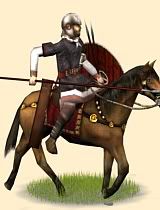
(Equites Auxilia - East) (Equites Scutarii)

(Equites Scutarii) (Equites Sagitarii)
(Equites Catafractarii Sarmatian) (Equites Mauri)
Field Army Units
Infantry
Lanciarii












Auxilia Light Palatina



Heavy Infantry


















Sagitarii





Equites Units












Guard Units - Infantry

Guard Units - Equites





Mercenary Troops













